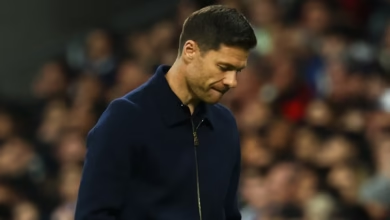Toothless Cityzens: Comprehensive Analysis of Manchester City’s Disappointing Defeat at Villa Park

Manchester City’s seemingly unstoppable momentum came to an abrupt halt on a frustrating Sunday afternoon at Villa Park, where Aston Villa secured a hard-fought 1-0 victory that sent shockwaves through the Premier League title race. The defeat was particularly significant as it exposed vulnerabilities in Pep Guardiola’s usually formidable attacking machine, with star striker Erling Haaland enduring one of his quietest performances of the campaign.
The result left Manchester City level on points with their arch-rivals Manchester United and a concerning six points behind Premier League leaders Arsenal. More troublingly for Guardiola and his coaching staff, the manner of the defeat raised questions about City’s ability to break down well-organized defensive units when their usual fluidity and creativity desert them. This comprehensive analysis examines the tactical battles, individual performances, and key moments that defined a match which could prove pivotal in the title race.
Pre-Match Context: City’s Confidence Meets Villa’s Determination
Manchester City arrived at Villa Park riding a wave of confidence, having navigated their previous nine fixtures across all competitions without tasting defeat. This impressive run had reinforced the perception that Guardiola’s side were building toward their characteristic late-season surge, the kind that has delivered multiple Premier League titles over recent years. The squad appeared to be hitting its stride at precisely the right moment, with key players returning to fitness and form coalescing across all departments.
Central to City’s recent success had been the relentless goalscoring exploits of Erling Haaland, the Norwegian phenomenon who had accumulated an astonishing 24 goals for club and country throughout the season. The towering striker had proven virtually unstoppable, with only Tottenham Hotspur managing to keep him off the scoresheet before this encounter. His presence alone was enough to strike fear into opposing defenses, forcing them to adopt increasingly desperate measures to contain his explosive pace and clinical finishing.
Aston Villa, however, approached the fixture with their own ambitions and tactical plan. Under their management, they had developed into a side capable of frustrating even the most talented opponents through disciplined defensive organization and dangerous counter-attacking football. The presence of players like Ollie Watkins, whose intelligent movement and tireless work rate had troubled many Premier League defenses, gave them a genuine threat on the break.
First Half Analysis: Early Promise Gives Way to Villa’s Breakthrough
The opening exchanges at Villa Park followed a predictable pattern, with Manchester City dominating possession and probing for weaknesses in Villa’s defensive structure. Guardiola’s side demonstrated their technical superiority through patient build-up play, working the ball methodically into promising wide areas where they hoped to create overloads and deliver dangerous crosses into the penalty area. However, these early forays lacked the incisive final delivery that has become synonymous with City’s attacking play, with crosses too often failing to find their intended targets or lacking the necessary quality to trouble Villa’s well-positioned defenders.
As the first half progressed, Aston Villa grew increasingly confident in their approach, gradually asserting themselves on the contest. The hosts’ tactical setup became clearer as they demonstrated their willingness to cede possession while maintaining defensive discipline and looking to exploit spaces left behind City’s characteristically high defensive line. This approach placed significant emphasis on the movement and decision-making of Ollie Watkins, the England international whose pace and positioning repeatedly stretched City’s backline.
Watkins’ movement proved particularly problematic for Ruben Dias and John Stones, City’s experienced central defensive partnership. The striker’s intelligent runs in behind forced both defenders into uncomfortable situations, compelling them to turn and sprint toward their own goal rather than defending on the front foot as they prefer. While Watkins continued to struggle with the kind of finishing that had plagued him in recent weeks, failing to capitalize on several promising opportunities, his contribution to Villa’s overall gameplan remained invaluable.
The breakthrough arrived in the 19th minute through a moment that perfectly encapsulated Manchester City’s defensive frailties on the afternoon. Matty Cash, Villa’s energetic full-back, found himself with time and space on the edge of the penalty area—a situation that should never materialize against a team of City’s defensive pedigree. Both Bernardo Silva and Erling Haaland failed to close down the Villa defender with sufficient urgency, allowing Cash the precious seconds he needed to shift the ball onto his stronger left foot.
From approximately 20 yards out, Cash unleashed a powerful strike that arrowed toward the bottom corner of Gianluigi Donnarumma’s goal. The Italian goalkeeper, despite his world-class reputation and impressive reflexes, could only watch as the ball nestled into the net, sending the Villa Park crowd into rapturous celebration. The goal was a testament to both Cash’s technical ability and Manchester City’s uncharacteristic lack of defensive intensity in a crucial moment.
City’s response to falling behind was immediate but ultimately ineffective. Haaland, so often the man to provide instant solutions to such setbacks, managed to work a shooting opportunity but could only direct a tame effort straight at Emi Martinez, Villa’s Argentine goalkeeper. The shot lacked the conviction and power that typically characterizes Haaland’s finishing, offering an early indication that this would not be one of his more memorable performances.
A controversial moment occurred when Josko Gvardiol appeared to push Morgan Rogers inside the penalty area, an incident that could easily have resulted in Villa being awarded a spot-kick. However, the Croatian defender showed remarkable restraint—or perhaps made a costly error of judgment—by offering no appeal or complaint about the contact. Whether this was sporting integrity or a missed opportunity to prevent VAR intervention remained a matter of debate.
Villa came closest to doubling their advantage before the halftime whistle when captain John McGinn unleashed another long-range effort that fizzed narrowly past Donnarumma’s post. The chance served as a reminder that Villa possessed the attacking quality to punish City’s defensive vulnerabilities, even as the visitors continued to dominate territorial possession.
Second Half Struggles: City’s Attacking Impotence Exposed
The second half began with Manchester City inevitably dominating possession, pushing Villa deeper into their own half as they desperately sought an equalizer. However, possession alone proved insufficient against opponents who had clearly prepared their defensive shape meticulously. Villa demonstrated impressive discipline, maintaining their compact defensive structure while remaining alert to counter-attacking opportunities.
Pep Guardiola’s tactical approach, typically so effective in breaking down stubborn defenses, struggled to generate the kind of clear-cut chances that his team’s dominance of the ball suggested they should be creating. The lack of creativity and incision in the final third became increasingly frustrating for City’s supporters, as wave after wave of attacks broke down against Villa’s well-drilled defensive unit.
Around the hour mark, Manchester City manufactured what appeared to be a golden opportunity to restore parity. Savinho, the Brazilian winger whose quick feet and energetic running had caused Villa problems throughout the match, found himself with space inside the penalty area just seven yards from goal. His low drive seemed destined for the net, only for Pau Torres to produce a moment of defensive brilliance, somehow managing to flick the ball over the crossbar with an acrobatic intervention. The save exemplified Villa’s determination to protect their slender advantage, with every player willing to put their body on the line.
At the opposite end of the pitch, Aston Villa continued to threaten on the counter-attack, exploiting the spaces that inevitably opened up as Manchester City committed more players forward in search of an equalizer. Jadon Sancho, the former Manchester City academy prospect who had rebuilt his career after struggles at Manchester United, nearly doubled Villa’s lead with a dangerous effort that forced Donnarumma into action. The Italian goalkeeper initially created problems for himself by palming the ball into Sancho’s path, but recovered impressibly to make a second save, preventing what would have been a devastating blow to City’s title aspirations.
Erling Haaland’s frustration became palpable as the second half wore on. The Norwegian striker, so accustomed to dominating matches and finding the net with regularity, barely had a meaningful touch of the ball in Villa’s penalty area. His service from teammates was poor, with through balls either overhit or cut out by Villa’s defenders, and crosses failing to find him in dangerous positions. When Haaland did finally think he had broken his duck, sliding the ball home from close range, his celebrations were cut short by the offside flag. The goal was correctly disallowed, with Omar Marmoush having strayed into an offside position earlier in the build-up play.
Adding insult to injury, Haaland’s afternoon ended in physical pain when he collided heavily with the post while pursuing another opportunity. The incident served as a metaphor for his entire performance—full of effort but ultimately fruitless, leaving him frustrated and his team defeated.
Tactical Analysis: Where Guardiola’s Masterplan Failed
Pep Guardiola’s tactical setup, while typically sophisticated and effective, proved inadequate against Aston Villa’s well-executed gameplan. City’s high defensive line, usually an asset that allows them to press opponents aggressively and dominate territory, became a liability against Watkins’ intelligent movement. The England striker repeatedly found space in behind, forcing City’s defenders into uncomfortable defensive actions and preventing them from playing with their usual confidence and composure.
John Stones’ tendency to step into midfield, a tactical innovation that has brought City success in recent seasons, left the defense vulnerable to quick transitions. While Stones is undoubtedly comfortable in possession and capable of progressing the ball effectively from deep positions, his movement forward left City with only three defenders to contend with Villa’s attacking threats. This numerical disadvantage became particularly problematic when Villa won possession and launched counter-attacks at pace.
In midfield, City struggled to establish their usual control and rhythm. Phil Foden, deployed in his preferred central playmaking role, found himself crowded out by Villa’s midfielders, unable to find the pockets of space that he typically exploits so effectively. Tijjani Reijnders showed glimpses of his ability to drive through midfield with the ball at his feet, but his decision-making in the final third left much to be desired, epitomized by a wayward shot that sailed well off target when a pass to a better-positioned teammate would have been the more intelligent option.
Bernardo Silva, usually one of City’s most influential players with his tireless running and technical excellence, enjoyed a bright opening period but gradually faded from the contest. His inability to impose himself on proceedings prompted Guardiola to withdraw him from the action as the manager desperately sought inspiration from his substitutes’ bench.
Individual Performances: A Collective Failure
Gianluigi Donnarumma (5/10): The Italian goalkeeper could hardly be blamed for Villa’s opening goal, with the defensive players in front of him failing to provide adequate protection by closing down Cash with sufficient urgency. Donnarumma demonstrated his willingness to act as a sweeper-keeper, comfortable coming off his line to deal with balls played in behind the defense. His reflexes remained sharp throughout, as evidenced by his double save from Sancho, even if he had initially created the danger by parrying into the winger’s path.
Matheus Nunes (4/10): The Portuguese international once again found himself deployed at full-back despite this clearly not being his natural position. While Nunes has shown admirable versatility in adapting to Guardiola’s tactical demands, his defensive limitations were exposed on several occasions. Villa would have expected Sancho to cause more problems, and the winger did manage to slip past Nunes with concerning ease at one stage, highlighting the tactical compromise involved in playing a midfielder in defense.
Ruben Dias (5/10): The Portuguese center-back endured a challenging afternoon, frequently finding himself isolated against the lively Watkins. City’s high defensive line, combined with the striker’s intelligent movement, forced Dias into uncomfortable situations where he was turning and chasing back toward his own goal rather than defending proactively. The ease with which Villa’s direct play bypassed City’s press left the defensive unit exposed far too often.
John Stones (4/10): While Stones remains comfortable in possession and technically accomplished, his tendency to step into midfield left City vulnerable at the back. His contribution to City’s attacking play proved insufficient to justify the defensive risks his positioning created. Like Dias, he struggled to cope with Watkins’ movement and found himself beaten too easily on several occasions.
Josko Gvardiol (5/10): The Croatian defender followed his usual instructions to push forward at every opportunity, but this attacking intent inevitably left space behind for Villa to exploit. The incident involving Rogers in the first half raised questions about his decision-making, as a more aggressive appeal might have prompted VAR to intervene on a potential penalty decision.
Tijjani Reijnders (5/10): Demonstrated his ability to carry the ball through midfield effectively, but his final-third decision-making left much to be desired. A wayward shot that flew well off target when teammates were better positioned epitomized his afternoon. His yellow card for a clumsy challenge on Watkins further demonstrated a lack of composure.
Phil Foden (5/10): Despite enjoying his central playmaking role throughout the season, Foden was unable to exert his usual influence. Villa’s defensive organization successfully prevented him from finding space between the lines, limiting his ability to create chances. One well-struck second-half effort that was blocked represented his most notable contribution. A booking for a challenge while tracking back on a Villa counter-attack illustrated his frustration.
Bernardo Silva (4/10): Started brightly, drifting intelligently into wide areas and finding pockets of space in dangerous positions. However, his influence waned significantly as the match progressed, with the Portuguese midfielder unable to impose himself on proceedings in the way City desperately needed. His substitution reflected Guardiola’s dissatisfaction with his contribution.
Savinho (5/10): The Brazilian winger demonstrated impressive footwork and tireless running, consistently getting into promising positions. However, his end product proved woefully inadequate, with final balls and decisions repeatedly letting down his teammates. A yellow card for a reckless tackle on Rogers and two missed opportunities in the second half, both blocked by Villa defenders, summed up a frustrating afternoon despite his industry.
Oscar Bobb (4/10): City struggled to provide him with service in areas where he could hurt Villa, with his most notable contributions coming when tracking back to fulfill defensive duties. His removal midway through the second half surprised nobody, as Guardiola sought greater creative impetus from his attacking players.
Erling Haaland (4/10): Remarkably, the Norwegian striker registered more touches in his own penalty area than Villa’s during a shockingly quiet first half. His only genuine sight of goal saw him open up his body too much and fire a weak effort straight at Martinez. The second half brought little improvement, with his service from teammates proving inadequate. A disallowed goal, following Marmoush’s offside position in the build-up, and a painful collision with the post capped a thoroughly miserable afternoon for a player accustomed to dominating Premier League defenses.
Conclusion: Title Race Implications
This defeat at Villa Park represents more than just three lost points for Manchester City. It exposes vulnerabilities in their attacking play when faced with well-organized, disciplined opposition willing to sacrifice possession and defend deep. The inability to break down Villa’s defense, combined with Haaland’s uncharacteristic anonymity, raises questions about City’s ability to maintain their challenge for the Premier League title.
With Arsenal now six points clear at the summit and Manchester United level on points, City can ill afford further slip-ups. Guardiola must find solutions to his team’s creative struggles and ensure that such toothless performances become anomalies rather than indicators of deeper problems. The title race remains wide open, but this defeat at Villa Park may yet prove decisive in determining where the trophy resides come season’s end.














